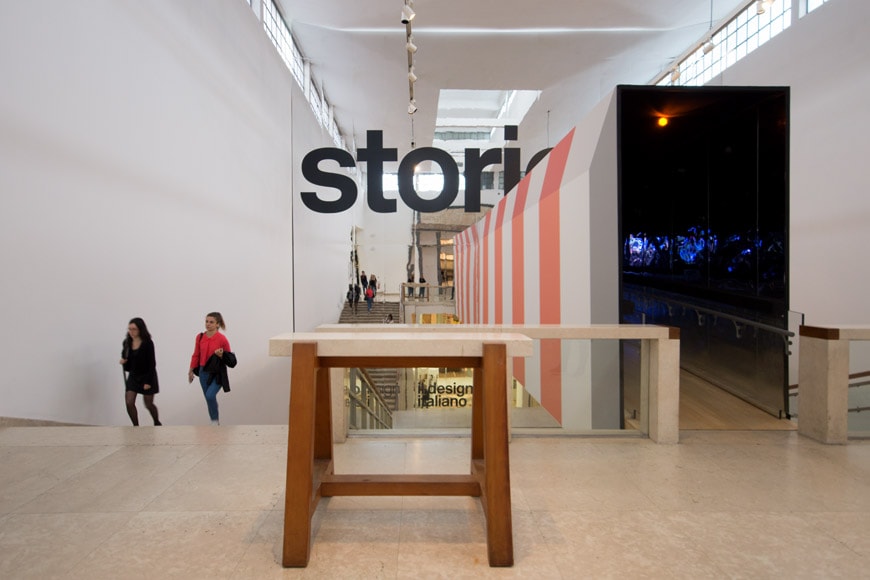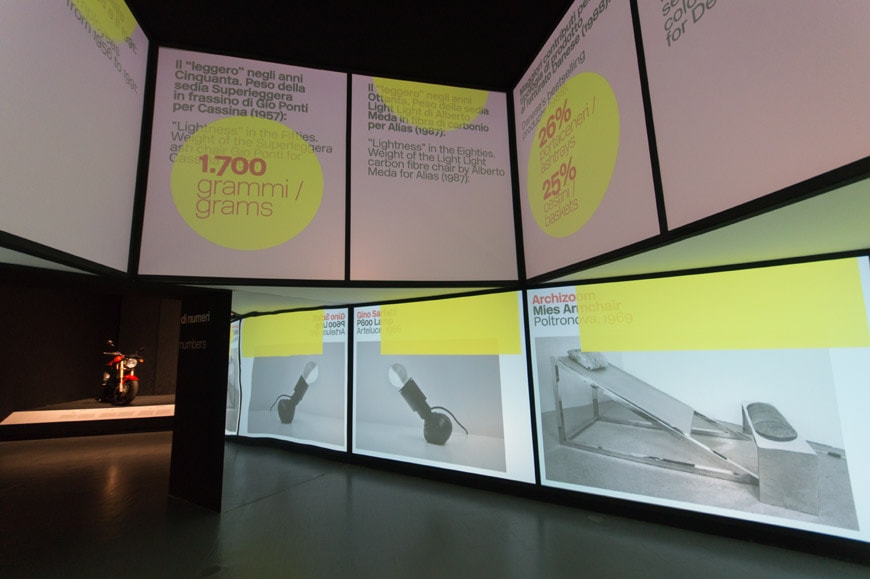Italian Icons at the 11th Milan Triennale Design Museum
Triennale Design Museum
Direction: Silvana Annicchiarico
Curated by Chiara Alessi, Maddalena Dalla Mura, Manolo de Giorgi, Vanni Pasca, Raimonda Riccini
Exhibition design: Calvi Brambilla
Stories. Italian Design – the 11th edition of the Triennale Design Museum
Until January 2019, the Triennale di Milano features the 11th edition of its Design Museum semi-permanent exhibition. Entitled “Stories. Italian Design” the exhibition presents 180 objects, made from 1902 to 1998 and arranged in chronological order, that the curators selected as iconic examples of 20th-century Italian design. But, what makes an object an icon? To be considered iconic by many? To transcend time? There are many possible answers and probably everyone has his own; certainly, an object can be defined as iconic when it symbolically embodies a precise historical period either from a technical, aesthetic, or cultural point of view. Therefore, a design icon is not “just” a working tool, a chair, or a vehicle, but has become an object that epitomizes the period in which it was designed, manufactured, and used.
Many of such objects have represented (and sometimes anticipated) their times so well that they have been used by media – in cinema, television, and advertising – as they were real actors, thus becoming permanently part of our collective imagination.
Alongside the Design Icons section, the exhibition features five thematic sections focused on Politics (“Power and forms. When designers engage with politics”, curated by Vanni Pasca); Geography, and Economics (Maps, and Stock Exchange, both curated by Manolo de Giorgi); on Technology (From the transistor to the Moon. Design and technology, curated by Raimonda Riccini); and on Communication (Images and Public Imagination: between photographs and magazines, curated by Maddalena Dalla Mura).
Triennale di Milano, “Stories. The Italian Design”. Left: two icons of the post-war period, the Lambretta, produced by Milan’s Industria Meccanica Innocenti since 1947, and the Piaggio Vespa designed by Corradino d’Ascanio in 1946. Background: the Isetta automobile. Foreground: two Olivetti typewriters, and the pioneering 720 Lady chair designed by Marco Zanuso, which was awarded the gold medal at the IX Milan’s Triennale in 1951.
Photo © Inexhibit
Triennale di Milano, “Stories. The Italian Design”. Foreground: the Isetta, one of the first examples of a microcar, produced by Iso from 1953 to 1956; a screen by Piero Fornasetti (1950); right: the P40 chair designed by Osvaldo Borsani manufactured by Tecno in 1950 and, hanging from the ceiling, a Superleggera chair designed by Giò Ponti in 1855, produced by Cassina since 1957. Photo © Inexhibit
Triennale di Milano, “Stories. The Italian Design”. The revolutionary Arco lamp by Achille and Pier Giacomo Castiglioni is the first example of a pendant lamp to be placed on the floor; background: Sideboard (1957) designed by Angelo Mangiarotti and produced by Frigerio Cantù. Photo © Inexhibit
Triennale di Milano, “Stories. The Italian Design” Three ceramic pieces designed by Ettore Sottsass Jr. and produced by Bitossi in 1959. Photo © Inexhibit
Triennale di Milano, “Stories. The Italian Design”. From the late 1950s, designers engage with new types of products: the Automatic 5 washing machine designed by Piero Geranzani for Candy in 1959, and the Supercortemaggiore fuel dispenser (1963) by Marcello Nizzoli.
Photo © Inexhibit
Triennale di Milano, “Stories. The Italian Design” Two pop design icons of the 1960s and 1970s; left: the Up5_6 chair (1969) by Gaetano Pesce, right: the Joe chair (1971) by De Pas, D’Urbino e Lomazzi. Photo © Inexhibit
Triennale di Milano, “Stories. The Italian Design” The Fiat Panda (1980) by Giorgetto Giugiaro, and the Alfatec canister vacuum cleaner (1974) designed by Attilio Pagani and Francesco Trabucco. Photo © Inexhibit
Triennale di Milano, “Stories. The Italian Design” A sequence of pieces of furniture from the 1980s and 1990s; foreground: Carlton bookcase (1981) designed by Ettore Sottsass for Memphis and, hanging from the ceiling, the Titania lamp designed by Alberto Meda and Paolo Rizzatto for Luceplan in 1989.Photo © Inexhibit
Triennale di Milano, “Stories. The Italian Design” The section on the relationship between design and politics, curated by Vanni Pasca. Photo © Inexhibit
Triennale di Milano, “Stories. The Italian Design” The impetuous growth of consumer electronics audio and video device production was made possible by innovation and miniaturization in electronics, as well as by the introduction of new materials, such as isotactic poly, allowing the manufacturing of more “friendly-looking” products with vivid colors and pleasant to touch.
Photo © Inexhibit
Triennale di Milano, “Stories. The Italian Design” The “Stock Exchange”, is an immersive space curated by Manolo de Giorgi. Photo © Inexhibit
Triennale di Milano, “Stories. The Italian Design” The tunnel at the end of the exhibition “invites” “invites” visitors to make a drawing of their favorite design icon. Photos © Inexhibit
TRIENNALE DESIGN MUSEUM
STORIES. ITALIAN DESIGN
temporary exhibition
14 APR 2018 / 20 JAN 2019

Opened in 2007 in the Palazzo dell’Arte, the Triennale Design Museum in Milan is the most important museum in Italy exclusively focused on Industrial Design

Milan
copyright Inexhibit 2025 - ISSN: 2283-5474















